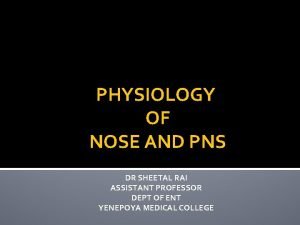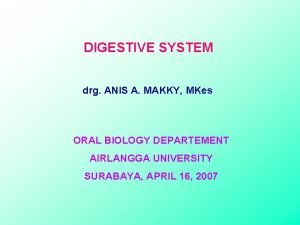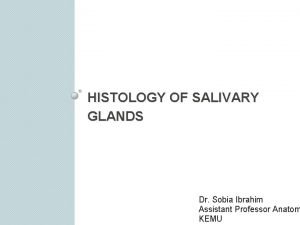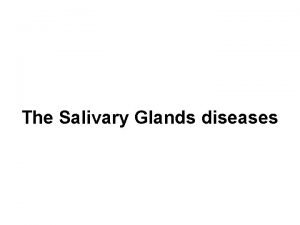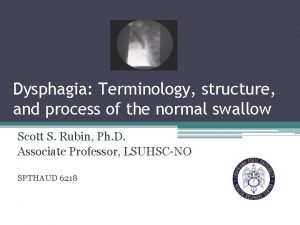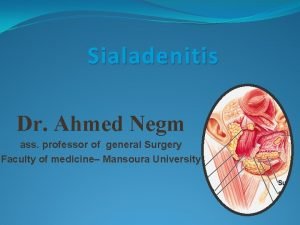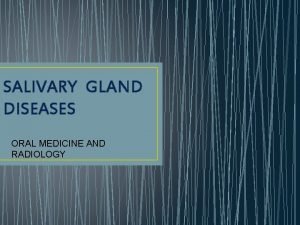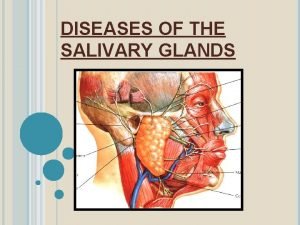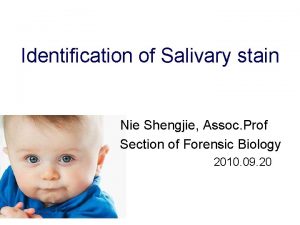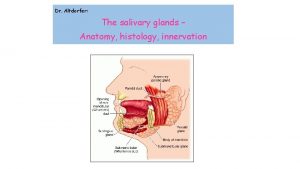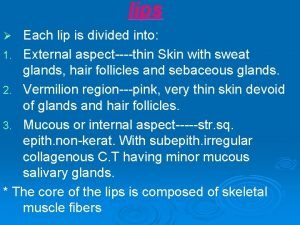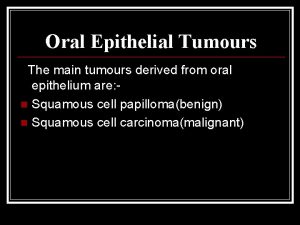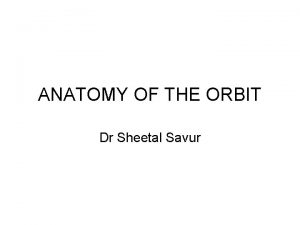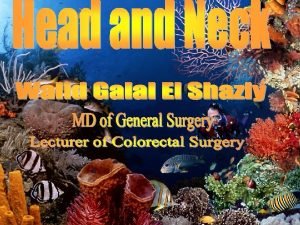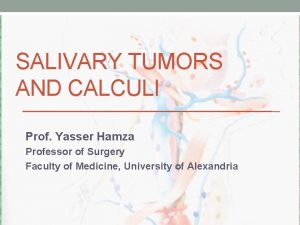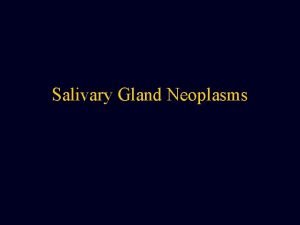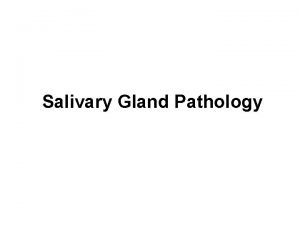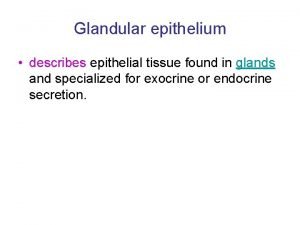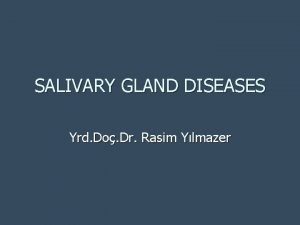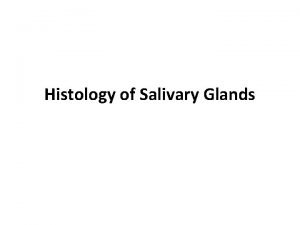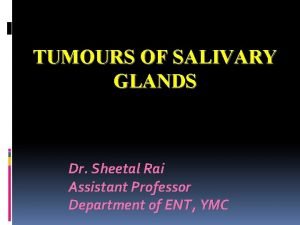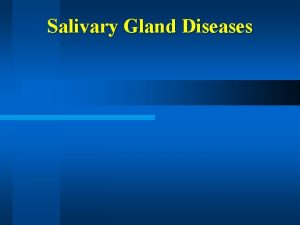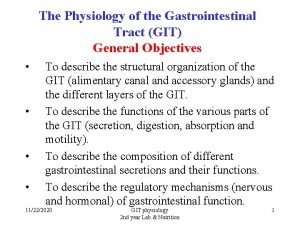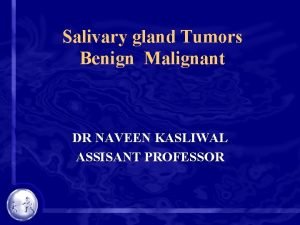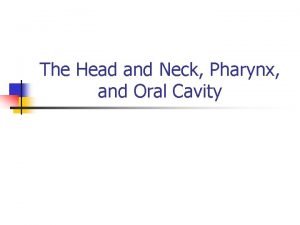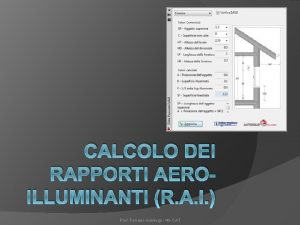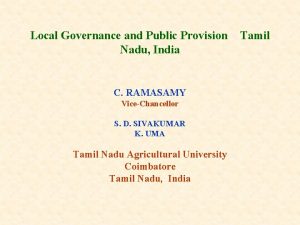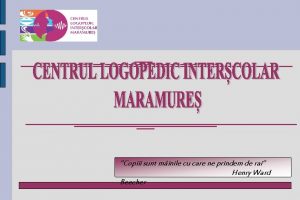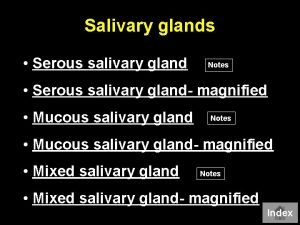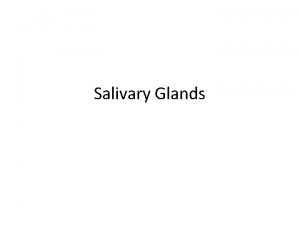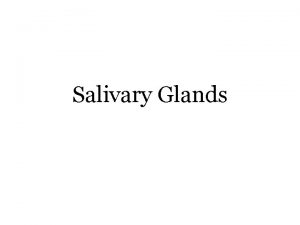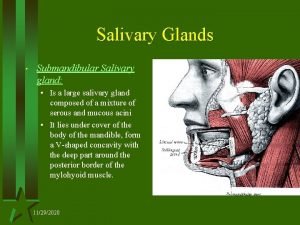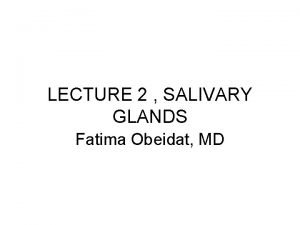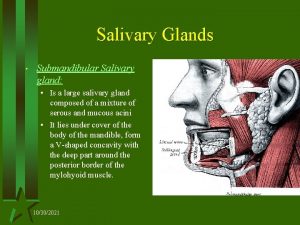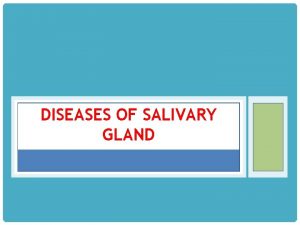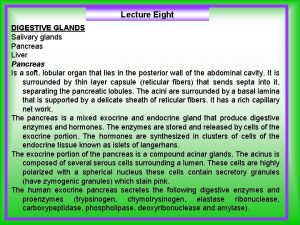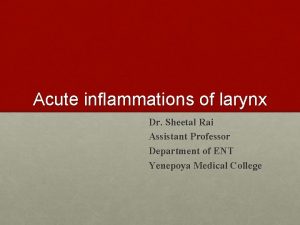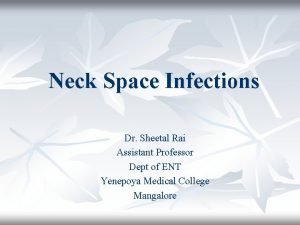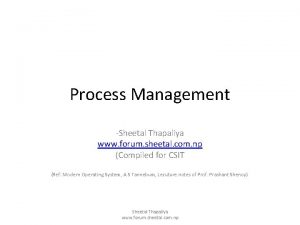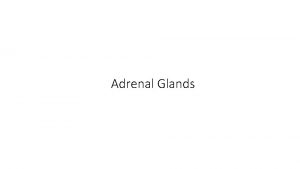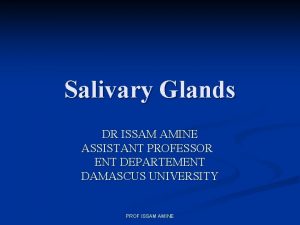TUMOURS OF SALIVARY GLANDS Dr Sheetal Rai Assistant











































![CT Scan– [ L ] Parotid CT Scan– [ L ] Parotid](https://slidetodoc.com/presentation_image_h/235f7cb5e48dbcbaa301c602e4dea4c6/image-44.jpg)







- Slides: 51

TUMOURS OF SALIVARY GLANDS Dr. Sheetal Rai Assistant Professor Department of ENT, YMC

SALIVARY GLAND NEOPLASMS Relatively uncommon 2% of head and neck neoplasms. 75% of tumours are benign. Distribution Parotid: 80% overall; 80% benign Submandibular: 15% overall; 50% benign Sublingual/minor: 5% overall; 40% benign

AETIOLOGY Smoking Alcohol consumption EBV Infection Radiation & chemotherapy induced Aflatoxin B

PRESENTATION Slowly growing over long period Parotid tumours – firm mass behind angle of mandible, in front of tragus. Deep lobe tumours displace tonsil & soft palate medially.


Submandibular gland tumours present in submandibular triangle , can be localised accurately by bimanual palpation. Minor salivary gland tumours of oral & pharyngeal mucosa present as firm submucosal swellings.

Features of a Malignant tumour : Rapid growth Restricted mobility Fixity of overlying skin Pain Facial palsy

INVESTIGATIONS Ultrasound MRI CT scan FNAC




SALIVARY GLAND TUMOURS Benign Pleomorphic adenoma Warthin’s tumour Oncocytoma Monomorphic adenoma Hemangioma Lymphangioma Malignant Mucoepidermoid carcinoma Adenoid cystic carcinoma Acinic cell carcinoma Adenocarcinoma Malignant mixed tumour Squamous cell carcinoma Undifferentiated carcinoma Lymphoma Sarcoma

PLEOMORPHIC ADENOMA Most common of all salivary gland neoplasms 70% of parotid tumors 50% of submandibular tumors 45% of minor salivary gland tumors 6% of sublingual tumors 4 th-6 th decade Slow growing painless mass

PLEOMORPHIC ADENOMA Gross pathology Smooth Well-demarcated Solid Cystic changes Myxoid stroma

PLEOMORPHIC ADENOMA Histology: Mixture of epithelial, myopeithelial and stromal components Epithelial cells: nests, sheets, ducts, trabeculae Stroma: myxoid, chrondroid, fibroid, osteoid No true capsule

Treatment: Complete surgical excision Ø Superficial Parotidectomy with facial nerve preservation. Ø Submandibular gland excision. Ø Wide local excision of minor salivary glands.

PAROTID

SUBMANDIBULAR GLAND


WARTHIN’S TUMOR Synonyms : - Papillary cystadenoma lymphomatosum - Adenolymphoma 6 -10% of parotid neoplasms Older males 10% bilateral or multicentric Presentation: slow-growing, painless mass

WARTHIN’S TUMOR Gross pathology Encapsulated Smooth/lobulated surface Cystic spaces with viscous fluid, shaggy epithelium Solid areas with white nodules representing lymphoid follicles

WARTHIN’S TUMOR Histology Papillary projections into cystic spaces surrounded by lymphoid stroma Epithelium: double cell layer Luminal cells Basal cells Stroma: mature lymphoid follicles with germinal centers

Treatment : Enucleation or surgical excision.

ONCOCYTOMA Rare: 2% of benign salivary tumors 6 th decade Parotid: 78% Submandibular gland: 9% Minor salivary glands: palate, buccal mucosa, tongue

ONCOCYTOMA Gross Encapsulated Homogeneous, smooth Orange/rust color Histology Cords of uniform cells and thin fibrous stroma Large polyhedral cells Granular, eosinophilic cytoplasm Central, round, vesicular nucleus

ONCOCYTOMA Electron microscopy: Mitochondrial hyperplasia 60% of cell volume Ø Treatment : Excision

MONOMORPHIC ADENOMAS Basal cell adenoma Most common 6 th decade Most common in parotid

BASAL CELL ADENOMA Solid nests of tumor cells Uniform, hyperchromatic, round nuclei. Peripheral nuclear palisade Jig saw puzzle appearance

BASAL CELL ADENOMA Trabecular Cells in elongated trabecular pattern Vascular stroma

BASAL CELL ADENOMA Tubular Multiple duct-like structures Columnar cell lining Vascular stroma

MONOMORPHIC ADENOMAS Canalicular adenoma 7 th decade Most common in minor salivary glands of the upper lip (74%) Painless submucosal mass

CANALICULAR ADENOMA Histology: Well-circumscribed Multiple foci Tubular structures lined by columnar or cuboidal cells Vascular stroma

MALIGNANT NEOPLASMS Mucoepidermoid carcinoma Adenoid cystic carcinoma Acinic cell carcinoma Adenocarcinoma Squamous cell carcinoma Clear cell carcinoma Carcinoma ex-pleomorphic adenoma

MUCOEPIDERMOID CARCINOMA Most common salivary gland malignancy 5 -9% of salivary neoplasms Parotid 45 -70% of cases Palate 18% 3 rd-8 th decade, peak in 5 th decade Pain, swelling, facial palsy, lymphadenopathy.

Mucoepidermoid carcinoma ------ minor salivary glands -----more aggressive-------behaves like Adenoid Cystic carcinoma Mucoepidermoid carcinoma ------ major salivary glands -----less aggressive-------behaves like Pleomorphic adenoma

MUCOEPIDERMOID CARCINOMA Gross pathology Well-circumscribed to partially encapsulated to unencapsulated Solid tumor with cystic spaces

MUCOEPIDERMOID CARCINOMA Histology—Low-grade Mucus cells > epidermoid cells Prominent cysts Mature cellular elements

MUCOEPIDERMOID CARCINOMA Histology—High-grade Epidermoid > mucus Solid tumor cell proliferation

MUCOEPIDERMOID CARCINOMA Treatment: Influenced by site, stage, grade Low grade �Wide local excision High grade �Radical excision +/- neck dissection (high incidence of microscopic spread of the tumour) �+/- postoperative radiation therapy

ADENOID CYSTIC CARCINOMA Overall 2 nd most common malignancy Most common in submandibular, sublingual and minor salivary glands 5 th decade Presentation ……………. Locally aggressive…………… Pain, paresthesia, facial weakness/paralysis

ADENOID CYSTIC CARCINOMA Gross pathology Well-circumscribed Solid, rarely with cystic spaces Infiltrative

ADENOID CYSTIC CARCINOMA Histology— cribriform pattern Most common “swiss cheese” appearance

ADENOID CYSTIC CARCINOMA Histology—tubular pattern Layered cells forming ductlike structures Basophilic mucinous substance Histology—solid pattern Solid nests of cells without cystic or tubular spaces
![CT Scan L Parotid CT Scan– [ L ] Parotid](https://slidetodoc.com/presentation_image_h/235f7cb5e48dbcbaa301c602e4dea4c6/image-44.jpg)
CT Scan– [ L ] Parotid

ADENOID CYSTIC CARCINOMA Treatment Complete local excision Tendency for perineural invasion: facial nerve sacrifice Postoperative RT Prognosis Local recurrence: 42% Distant metastasis: lung -70%, liver, bone. -- 5 -year survival 75%, 20 -year survival 13%

ACINIC CELL CARCINOMA 2 nd most common parotid and pediatric malignancy 5 th decade Bilateral parotid disease in 3% Presentation Solitary, slow-growing, often painless mass

ACINIC CELL CARCINOMA Treatment Complete local excision +/- postoperative RT Prognosis 5 -year survival: 82%

ADENOCARCINOMA More common in minor salivary glands Locally aggressive Distant metastases

ADENOCARCINOMA Treatment Complete local excision Neck dissection Postoperative RT Prognosis Local recurrence: 51% Regional metastasis: 27% Distant metastasis: 26%

MALIGNANT MIXED TUMORS Carcinoma ex-pleomorphic adenoma Carcinoma developing in the epithelial component of preexisting pleomorphic adenoma Carcinosarcoma True malignant mixed tumor—carcinomatous and sarcomatous components Metastatic mixed tumor Metastatic deposits of otherwise typical pleomorphic adenoma

THANK YOU
 Sheetal rai
Sheetal rai Minor salivary glands
Minor salivary glands Intestinal structure
Intestinal structure Histology of parotid gland
Histology of parotid gland Gall bladder function
Gall bladder function Submandibular gland excision
Submandibular gland excision Dysphagia terminology
Dysphagia terminology Salivary gland swelling
Salivary gland swelling Function of salivary glands
Function of salivary glands Sialography
Sialography Sialography
Sialography Phadebas paper
Phadebas paper Nerve supply of parotid gland
Nerve supply of parotid gland Minor salivary glands
Minor salivary glands Tongue rough edges
Tongue rough edges Merocrine
Merocrine Clusterknoppix
Clusterknoppix Dr sheetal kale
Dr sheetal kale Oncocytoma salivary gland
Oncocytoma salivary gland Salivary gland tumor
Salivary gland tumor Caries risk assessment form
Caries risk assessment form Oncocytoma salivary gland
Oncocytoma salivary gland Warthin tumor
Warthin tumor Simple branched alveolar gland
Simple branched alveolar gland Salivary gland disease classification
Salivary gland disease classification Xerotrachea
Xerotrachea Salivary amylase digestion of starch
Salivary amylase digestion of starch Mucous acini
Mucous acini Pleomorphic adenomas
Pleomorphic adenomas Cylindroma slideshare
Cylindroma slideshare Role of bile juice in digestion
Role of bile juice in digestion Fosdick test
Fosdick test Oncocytoma salivary gland
Oncocytoma salivary gland Salivary gland
Salivary gland Rai narita
Rai narita Schema calcolo rai con aggetto
Schema calcolo rai con aggetto Balwant rai mehta committee
Balwant rai mehta committee Piattaforma acquisti rai
Piattaforma acquisti rai Rai kamaluddin
Rai kamaluddin Naomi rai
Naomi rai Sudhendu rai
Sudhendu rai Trombocitop
Trombocitop Rai cmh
Rai cmh Naomi rai
Naomi rai Gvk rao committee recommendations
Gvk rao committee recommendations Rai koulutus
Rai koulutus Rai cereal
Rai cereal Richa rai
Richa rai Copiii sunt mainile cu care ne prindem de rai
Copiii sunt mainile cu care ne prindem de rai Aishwarya rai dhoom 2 weight loss
Aishwarya rai dhoom 2 weight loss Lady rai
Lady rai Rai diagnostic
Rai diagnostic
